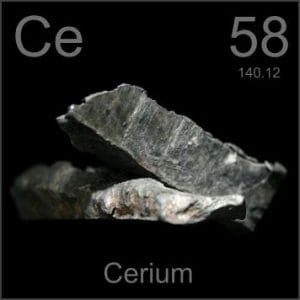Cerium Samarium Sputtering Target Description

Related Product: Cerium Sputtering Target

Related Product: Samarium Sputtering Target
Chemical Formula: Ce/Sm
Catalog Number: ST0070
CAS Number: 7440-45-1 | 7440
Purity: 99.9%
Shape: Discs, Plates, Column Targets, Step Targets, Custom-made
Cerium Samarium sputtering target come in various forms, purities, sizes, and prices. Thin Film Materials (TFM) manufactures and supplies top-quality sputtering targets at competitive prices.
The cerium-gadolinium sputtering target offered by TFM is a silvery alloy material that includes cerium (Ce) and gadolinium (Gd). This high-quality target is ideal for applications that require the unique properties of these elements.

Cerium, represented by the symbol “Ce,” is a chemical element named after Ceres, the Roman goddess of agriculture. It was first identified in 1803 by scientists H. Klaproth, J. Berzelius, and W. Hisinger. The element was later isolated by G. Mosander. Cerium holds the atomic number 58 in the periodic table, positioned in Period 6 and Group 3 within the f-block. It has a relative atomic mass of 140.116(1) Daltons, with the number in parentheses denoting the measurement uncertainty.
Related Product: Cerium Sputtering Target

Samarium, denoted by the symbol “Sm,” is a chemical element named after the mineral samarskite, from which it was first isolated. The element was discovered in 1879 by P.E.L. de Boisbaudran, who also achieved its isolation. Samarium has an atomic number of 62 and is situated in Period 6, Group 3 of the f-block in the periodic table. Its relative atomic mass is 150.36(2) Daltons, with the bracketed number indicating the uncertainty in measurement.
Related Product: Samarium Sputtering Target
Our cerium-samarium sputter targets are meticulously tagged and labeled for easy identification and stringent quality control. We take extensive precautions to prevent any damage during storage and transportation, ensuring the integrity and high quality of our products.
It’s the source material (in solid form) used in sputter deposition to eject atoms or molecules that then form a thin film on a substrate.
Targets can be pure metals (e.g., gold, copper, aluminum), ceramics (e.g., Al₂O₃, SiO₂, TiO₂), alloys, or composites—chosen based on the film’s desired properties.
They are produced by processes such as melting/casting for metals or sintering (often with hot isostatic pressing) for ceramics and composite targets to ensure high density and purity.
In a vacuum chamber, a plasma (typically argon) bombards the target, ejecting atoms that travel and condense on a substrate, forming a thin film.
Key factors include the target’s purity, density, grain structure, and the sputtering yield (i.e. how many atoms are ejected per incident ion), as well as operating conditions like power density and gas pressure.
Operators monitor target erosion (often by measuring the depth of the eroded “race track”) or track total energy delivered (kilowatt-hours) until it reaches a threshold that can compromise film quality.
Fragile materials (such as many ceramics or certain oxides) and precious metals often require a backing plate to improve cooling, mechanical stability, and to allow thinner targets that reduce material costs.
DC sputtering is used for conductive targets, while RF sputtering is necessary for insulating targets (like many oxides) because it prevents charge buildup on the target’s surface.
In reactive sputtering, a reactive gas (e.g., oxygen or nitrogen) is introduced to form compound films on the substrate, but it may also “poison” the target surface if not carefully controlled.
Many manufacturers prefer to control raw material quality by sourcing their own powders; using external powders can risk impurities and inconsistent target properties.
Targets should be stored in clean, dry conditions (often in original packaging or re-wrapped in protective materials) and handled with gloves to avoid contamination, ensuring optimal performance during deposition.
Deposition rate depends on factors such as target material and composition, power density, working gas pressure, substrate distance, and the configuration of the sputtering system (e.g., magnetron design).
Reviews
There are no reviews yet.